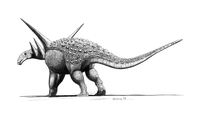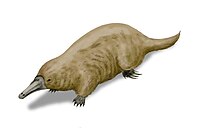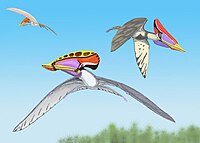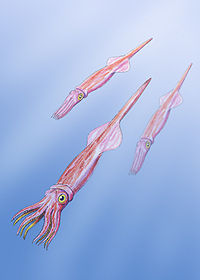Albian
System/ Period | Series/ Epoch | Stage/ Age | Age (Ma) | |
|---|---|---|---|---|
Paleogene | Paleocene | Danian | younger | |
Cretaceous | Upper/ Late | Maastrichtian | 66.0 | 72.1 |
Campanian | 72.1 | 83.6 | ||
Santonian | 83.6 | 86.3 | ||
Coniacian | 86.3 | 89.8 | ||
Turonian | 89.8 | 93.9 | ||
Cenomanian | 93.9 | 100.5 | ||
| Lower/ Early | Albian | 100.5 | ~113.0 | |
Aptian | ~113.0 | ~125.0 | ||
Barremian | ~125.0 | ~129.4 | ||
Hauterivian | ~129.4 | ~132.9 | ||
Valanginian | ~132.9 | ~139.8 | ||
Berriasian | ~139.8 | ~145.0 | ||
Jurassic | Upper/ Late | Tithonian | older | |
| Subdivision of the Cretaceous system according to the ICS, as of 2017.[1] | ||||
The Albian is both an age of the geologic timescale and a stage in the stratigraphic column. It is the youngest or uppermost subdivision of the Early/Lower Cretaceous epoch/series. Its approximate time range is 113.0 ± 1.0 Ma to 100.5 ± 0.9 Ma (million years ago). The Albian is preceded by the Aptian and followed by the Cenomanian.[2]
Contents
1 Stratigraphic definitions
2 Lithofacies
3 Paleontology
3.1 †Ankylosaurs
3.2 Birds (avian theropods)
3.3 Bony fish
3.4 Cartilaginous fish
3.5 †Ceratopsia
3.6 Crocodylomorphs
3.7 †Ichthyosaurs
3.8 Mammalia
3.9 †Ornithopods
3.10 †Plesiosaurs
3.11 †Pterosauria
3.12 †Sauropods
3.13 †Theropods (non-avian)
3.14 †Ammonites
3.14.1 †Ammonitida
3.14.1.1 Originating in Lower Albian strata
3.14.1.2 Originating in Middle Albian strata
3.14.1.3 Originating in Upper Albian strata
3.15 †Belemnites
3.16 Nautiloids
3.17 †Phylloceratida
4 References
4.1 Notes
4.2 Literature
5 External links
Stratigraphic definitions
The Albian stage was first proposed in 1842 by Alcide d'Orbigny. It was named after Alba, the latin name for River Aube in France,
A Global Boundary Stratotype Section and Point (GSSP), ratified by the IUGS in 2016, defines the base of the Albian as the first occurrence of the planktonic foraminiferan Microhedbergella renilaevis at the Col de Pré-Guittard section, Arnayon, Drôme, France.[3]
The top of the Albian stage (the base of the Cenomanian stage and Upper Cretaceous series) is defined as the place where the foram species Rotalipora globotruncanoides first appears in the stratigraphic column.[4]
The Albian is sometimes subdivided in Early/Lower, Middle and Late/Upper subages or substages. In western Europe, especially in the UK, a subdivision in two substages (Vraconian and Gaultian) is more often used.
Lithofacies
The following representatives of the Albian stage are worthy of notice: the phosphorite beds of the Argonne and Bray areas in France; the Flammenmergel of northern Germany; the lignites of Utrillas in Spain; the Upper sandstones of Nubia, and the Fredericksburg beds of North America.[5]
Paleontology
†Ankylosaurs
Ankylosaurs of the Albian | ||||
|---|---|---|---|---|
| Taxa | Presence | Location | Description | Images |
|  Acanthopholis  Animantarx  Pawpawsaurus  Sauropelta | |||
| ||||
| ||||
| Cedar Mountain Formation, Utah, USA | |||
| Aptian to ?Albian | Ulansuhai Formation, Inner Mongolia, China | ||
| ||||
| Aptian to Albian | Cloverly Formation, Wyoming, Montana, Utah, USA | A medium-sized nodosaurid, measuring about 5 meters (16.5 ft) long, Sauropelta had a distinctively long tail which made up about half of its body length. Its neck and back were protected by an extensive bony body armor including characteristically large spines | |
| Mongolia | |||
| Dakota Formation, Kansas, USA | A nodosaurid estimated to have been approximately four meters in length (13 ft). Besides the usual rounded and polygonal osteoderms, Silvisaurus may have also sported bony spines on its shoulders and tail | ||
| Late Albian to early Cenomanian | Frontier Formation, Wyoming, USA | A poorly known genus of nodosaurid | |
| Paw Paw Formation, Texas, USA | Poorly known, probably a nodosaurid | ||
Birds (avian theropods)
Birds of the Albian | ||||
|---|---|---|---|---|
| Taxa | Presence | Location | Description | Images |
|  Jeholornis | |||
| ||||
Bony fish
Bony fish of the Albian | ||||
|---|---|---|---|---|
| Taxa | Presence | Location | Description | Images |
|  Thrissops  Xiphactinus | |||
| Alabama, Georgia and Kansas, USA; Czech Republic; Canada; Australia | |||
Cartilaginous fish
Cartilaginous fish of the Albian | ||||
|---|---|---|---|---|
| Taxa | Presence | Location | Description | Images |
| Western Interior Seaway, North America |  Cretoxyrhina mantelli  Ischyodus  Scapanorhynchus | ||
| Europe, Russia, North America and New Zealand | |||
| ||||
†Ceratopsia
Ceratopsia of the Albian | ||||
|---|---|---|---|---|
| Taxa | Presence | Location | Description | Images |
| Gobi Desert, Mongolia | Had an intermediate phylogenetic position between Liaoceratops and Archaeoceratops within Neoceratopia |  Yamaceratops | |
Crocodylomorphs
Crocodylomorphs of the Albian | ||||
|---|---|---|---|---|
| Taxa | Presence | Location | Description | Images |
| Africa |  Sarcosuchus | ||
†Ichthyosaurs
Ichthyosaurs of the Albian | ||||
|---|---|---|---|---|
| Taxa | Presence | Location | Description | Images |
|  Platypterigius | |||
Mammalia
Mammals of the Albian | ||||
|---|---|---|---|---|
| Taxa | Presence | Location | Description | Images |
| several species from Hauterivian to Albian | Spain, Mongolia |  Steropodon | |
| Lightning Ridge, New South Wales, Australia | |||
| Lightning Ridge, New South Wales, Australia | |||
†Ornithopods
Ornithopods of the Albian | ||||
|---|---|---|---|---|
| Taxa | Presence | Location | Description | Images |
| Khukhtek Formation, Dornogovi Province, Mongolia | An advanced iguanodontian, just basal to the family Hadrosauridae |  Altirhinus  Eolambia  Leaellynasaura  Muttaburrasaurus  Nanyangosaurus  Probactrosaurus  Qantassaurus  Tenontosaurus  Theiophytalia | |
| Aptian/Albian | Dinosaur Cove, Victoria, Australia | 2–3 meters long hypsilophodont | |
| Albian-Cenomanian | Utah, USA | An iguanodont | |
| ||||
| ||||
| China | |||
| Mongolia | |||
| China | An early hadrosauroid iguanodont, about 17 – 20 feet (5 – 6 metres) in length. It had a narrow snout, an elongated lower jaw and double rows of flattened cheek teeth. It was a possible ancestor of the duck-billed dinosaurs. | ||
| ||||
| Barremian to Albian | |||
| ||||
| Aptian to Albian | Purgatoire Formation, Colorado, USA | An iguanodont described as intermediate in derivation between Camptosaurus and Iguanodon | |
| Aptian to Albian | Cloverly Formation, Montana, USA | Hypsilophodont | |
†Plesiosaurs
| †Plesiosauria of the Albian | ||||
|---|---|---|---|---|
| Taxa | Presence | Location | Description | Images |
| Aptian to Albian | Hughenden district, Queensland, Australia | Among the largest pliosaurs, body-length estimates put the total length of Kronosaurus at 9–10 meters |  Kronosaurus |
†Pterosauria
Pterosaurs of the Albian | ||||
|---|---|---|---|---|
| Taxa | Presence | Location | Description | Images |
| Berriasian-Albian | Cambridge Greensand, United Kingdom |  Coloborhynchus  Pterodaustro  Thalassodromeus  Tupuxuara  Zhejiangopterus | |
| Toolebuc Formation, Queensland, Australia | |||
| Morocco; Santana Formation, Brazil; Paw Paw Formation, Texas, USA | |||
| Albian-Turonian | Chalk Formation and Cambridge Greensand, England | ||
| Lianmuxin Formation, Xinjiang, China | |||
| Toolebuc Formation, Queensland, Australia | |||
| Cambridge Greensand, England | |||
| Valanginian to Albian | Lagarcito Formation, Argentina | ||
| Aptian or Albian | Santana Formation, Brazil | ||
| Aptian to early Albian | Santan do Cariri, Brazil; St Gallen, Switzerland | ||
| Albian or Cenomanian | Santana Formation, Brazil | ||
| ? | Zhejiang, China | ||
†Sauropods
Sauropods of the Albian | ||||
|---|---|---|---|---|
| Taxa | Presence | Location | Description | Images |
| Mid to Late Albian | Utah, USA |  Astrodon  Brontomerus  Sauroposeidon | |
| Egypt | The only known bones of this sauropod were destroyed in World War II. | ||
| Early Cretaceous | Brazil | ||
| Swampoodle, Arundel Formation, Prince George's County, Maryland; Antlers Formation, Oklahoma | |||
| Algeria | The bones referred to "B." nougaredi probably belong to more than one different species. | ||
| Atian-Albian | Utah | ||
| South America | |||
| Aptian or Albian | Montana | ||
| Aptian-early Albian | Oklahoma | This sauropod weighed up to 60 tonnes, making it one of the largest known dinosaurs. | |
| early Albian | Tunisia | Tataouinea had highly pneumatic pelvic bones, suggesting that sauropods had abdominal air sacs. | |
| Aptian-Albian | Cedar Mountain Formation, Utah | ||
| Winton Formation, Queensland, Australia | |||
†Theropods (non-avian)
Theropods of the Albian | ||||
|---|---|---|---|---|
| Taxa | Presence | Location | Description | Images |
| North America |  Acrocanthosaurus  Alxasaurus  Deinonychus  Fukuiraptor  Spinosaurus  Suchomimus  Utahraptor | ||
| Asia | |||
| Northern Africa | |||
| Niger | |||
| North America | |||
| France | |||
| Japan | |||
| France | |||
| South America | |||
| ||||
| Africa | |||
| Africa | |||
| Australia | |||
| North America | The largest known dromaeosaurid | ||
†Ammonites
†Ammonitida
- Moffitites
Originating in Lower Albian strata
The following is a list of Ammonite genera whose fossils are geochronologically found first in lower Albian strata. These genera may survive into later portions of the Albian stage, or even into later geological stages. This list should not be thought of in terms of the lifespan of the genera included.

Puzosia
- Aioloceras
- Anacleoniceras
- Anadesmoceras
- Anisoceras
- Arcthoplites
- Brancoceras
- Brewericeras
- Cleoniceras
- Cymahoplites
- Douvilleiceras
- Epileymeriella
- Eubranoceras
- Farnhamia
- Hoplites
- Kossmatella
- Labeceras
- Leconteites
- Lemuroceras
- Leymeriella
- Lyelliceras
- Neobibolites
- Otohoplites
- Oxytropidoceras
- Paracanthoplites
- Parasilesites
- Parengonoceras
- Plictetia
- Prohelicoceras
- Proleymeriella
- Prolyelliceras
- Protohoplites
- Pseudoleymeriella
- Pseudosonneratia
- Puzosia
- Puzosigella
- Rhytidohoplites
- Rossalites
- Silesitoides
- Sokolovites
- Sonneratia
- Tegoceras
- Tetrahoplites
- Tetrahoplitoides
- Zealandites
Originating in Middle Albian strata
The following is a list of Ammonite genera whose fossils are geochronologically found first in middle Albian strata. These genera may survive into later portions of the Albian stage, or even into later geological stages. This list should not be thought of in terms of the lifespan of the genera included.

Mortoniceras from South Africa
- Anagaudryceras
- Anahoplites
- Astiericeras
- Dimorphoplites
- Dipoloceras
- Dipoloceroides
- Engonoceras
- Epihoplites
- Euhoplites
- Falciferella
- Falloticeras
- Gastroplites
- Hamitoides
- Hysteroceras
- Isohoplites
- Manuaniceras
- Mojsisoviczia
- Mortoniceras
- Ostlingoceras
- Protengonoceras
- Proturrilitoides
- Pseudhelicoceras
- Scaphamites
- Subarcthoplites
- Sulcohoplites
- Turrilitoides
- Venezoliceras
- Zuluscaphites
Originating in Upper Albian strata
The following is a list of Ammonite genera whose fossils are geochronologically found first in upper Albian strata. These genera may survive into later portions of the Albian stage, or even into later geological stages. This list should not be thought of in terms of the lifespan of the genera included.

Scaphites
- Adkinsites
- Arestoceras
- Beudantiella
- Bhimaites
- Borissiakoceras
- Cainoceras
- Callihoplites
- Cantabrigites
- Cenisella
- Cottreauites
- Cyrtochilus
- Deiradoceras
- Diplasioceras
- Discohoplites
- Ellipsoceras
- Elobiceras
- Eogunnarites
- Eopachydiscus
- Eoscaphites
- Erioliceras
- Ficheuria
- Flickia
- Gaudryceras
- Gazdaganites
- Goodhallites
- Hemiptychoceras
- Hengestites
- Hypengonoceras
- Hyphoplites
- Idiohamites
- Karamaiceras
- Karamaites
- Koloceras
- Lechites
- Lepthoplites
- Lytodiscoides
- Mantelliceras
- Mariella
- Metengonoceras
- Myloceras
- Neogastroplites
- Neoharpoceras
- Neokentoceras
- Neophlycticeras
- Pachydesmoceras
- Paradolphia
- Paraturrilites
- Pervinquieria
- Plesiohamites
- Plesioturrilites
- Pleurohoplites
- Prohysteroceras
- Psilohamites
- Rusoceras
- Salaziceras
- Saltericeras
- Scaphites
- Schloenbachia
- Sciponoceras
- Semenovites
- Spathiceras
- Stoliczkaia
- Stomohamites
- Worthoceras
†Belemnites
Belemnites of the Albian | ||||
|---|---|---|---|---|
| Taxa | Presence | Location | Description | Images |
|  Belemnites | |||
| ||||
Nautiloids
Nautiloids of the Albian | ||||
|---|---|---|---|---|
| Taxa | Presence | Location | Description | Images |
|  An illustration of a variety of fossil nautiloids. | |||
†Phylloceratida
- Carinophylloceras
References
Notes
^ http://www.stratigraphy.org/index.php/ics-chart-timescale
^ For a detailed geologic timescale, see Gradstein et al. (2004)
^ Kennedy, J.W.; Gale, A.S.; Huber, B.T.; Petrizzo, M.R.; Bown, P.; Jenkyns, H.C. (2017). "The Global Boundary Stratotype Section and Point (GSSP) for the base of the Albian Stage, of the Cretaceous, the Col de Pré-Guittard section, Arnayon, Drôme, France". Episodes. 40 (3): 177–188. doi:10.18814/epiiugs/2017/v40i3/017021..mw-parser-output cite.citationfont-style:inherit.mw-parser-output qquotes:"""""""'""'".mw-parser-output code.cs1-codecolor:inherit;background:inherit;border:inherit;padding:inherit.mw-parser-output .cs1-lock-free abackground:url("//upload.wikimedia.org/wikipedia/commons/thumb/6/65/Lock-green.svg/9px-Lock-green.svg.png")no-repeat;background-position:right .1em center.mw-parser-output .cs1-lock-limited a,.mw-parser-output .cs1-lock-registration abackground:url("//upload.wikimedia.org/wikipedia/commons/thumb/d/d6/Lock-gray-alt-2.svg/9px-Lock-gray-alt-2.svg.png")no-repeat;background-position:right .1em center.mw-parser-output .cs1-lock-subscription abackground:url("//upload.wikimedia.org/wikipedia/commons/thumb/a/aa/Lock-red-alt-2.svg/9px-Lock-red-alt-2.svg.png")no-repeat;background-position:right .1em center.mw-parser-output .cs1-subscription,.mw-parser-output .cs1-registrationcolor:#555.mw-parser-output .cs1-subscription span,.mw-parser-output .cs1-registration spanborder-bottom:1px dotted;cursor:help.mw-parser-output .cs1-hidden-errordisplay:none;font-size:100%.mw-parser-output .cs1-visible-errorfont-size:100%.mw-parser-output .cs1-subscription,.mw-parser-output .cs1-registration,.mw-parser-output .cs1-formatfont-size:95%.mw-parser-output .cs1-kern-left,.mw-parser-output .cs1-kern-wl-leftpadding-left:0.2em.mw-parser-output .cs1-kern-right,.mw-parser-output .cs1-kern-wl-rightpadding-right:0.2em
^ See Kennedy et al. (2004) for a description of the GSSP for the Cenomanian
^ One or more of the preceding sentences incorporates text from a publication now in the public domain: Howe, John Allen (1911). "Albian". In Chisholm, Hugh. Encyclopædia Britannica. 1 (11th ed.). Cambridge University Press. p. 505.
One or more of the preceding sentences incorporates text from a publication now in the public domain: Howe, John Allen (1911). "Albian". In Chisholm, Hugh. Encyclopædia Britannica. 1 (11th ed.). Cambridge University Press. p. 505.
^ Mortimer, Mickey. "List of Dromaeosaurids". Archived from the original on October 3, 2011. Retrieved July 8, 2011.
Literature
.mw-parser-output .smallcapsfont-variant:small-caps
Gradstein, F.M.; Ogg, J.G. & Smith, A.G.; 2004: A Geologic Time Scale 2004, Cambridge University Press.
Kennedy, W.J.; Gale, A.S.; Lees, J.A. & Caron, M.; 2004: The Global Boundary Stratotype Section and Point (GSSP) for the base of the Cenomanian Stage, Mont Risou, Hautes-Alpes, France, Episodes 27, pp. 21–32.
d'Orbigny, A.C.V.M.; 1842: Paléontologie française: Terrains crétacés, vol. ii. (in French)
External links
- GeoWhen Database - Albian
Mid-Cretaceous timescale, at the website of the subcommission for stratigraphic information of the ICS (The top of the Albian stage is also still visible on their Late Cretaceous timescale)
Stratigraphic chart of the Lower Cretaceous, at the website of Norges Network of offshore records of geology and stratigraphy- Albian Stage, Cretaceous Period in Hampshire
